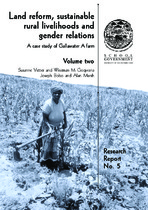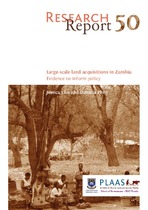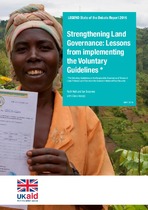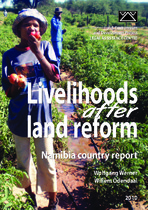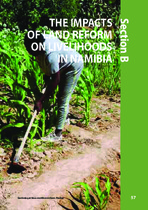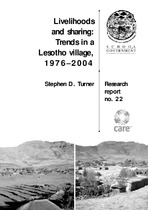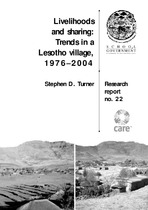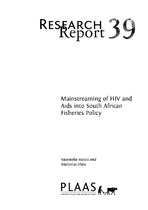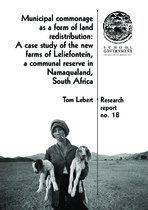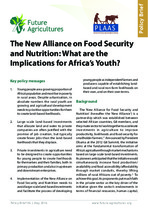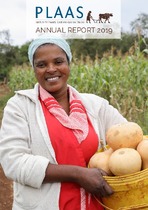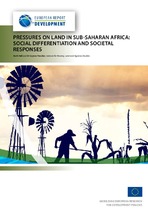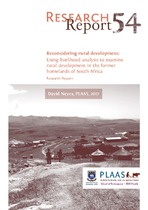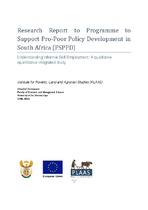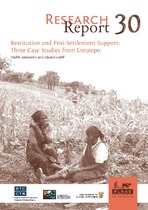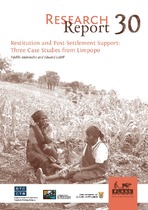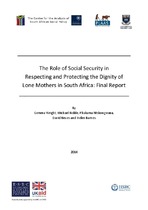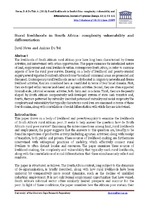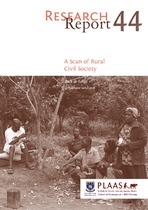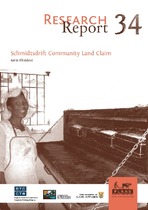Browsing Research Reports by Title
Now showing items 56-75 of 94
-
Land reform, sustainable rural livelihoods and gender relations: A case study of Gallawater A farm: Volume 2
(Institute for Poverty, Land and Agrarian Studies, University of the Western Cape, 2000)There is an ongoing debate about the sustainability of South African communal rangelands as old views on overgrazing and degradation are being widely challenged. The degradation issue has recently received renewed ... -
Large-scale land acquisitions in Zambia: Evidence to inform policy
(Institute for Poverty, Land and Agrarian Studies, University of the Western Cape, 2015)Land in Zambia plays a vital role in sustaining livelihoods, ensuring food security and reducing poverty. If people are not able to access land (including communal interests, such as lands for grazing or access to water ... -
LEGEND state of the debate report 2016 - Strengthening land governance: Lessons from implementing the Voluntary Guidelines
(Legend, 2017)The Voluntary Guidelines on the Responsible Governance of Tenure of Land, Fisheries and Forests in the Context of National Food Security (VGGT) are a globally agreed standard. Achieving this normative consensus in ... -
Livelihoods after land reform
(Institute for Poverty, Land and Agrarian Studies, University of the Western Cape, 2010)In 1990, Namibia emerged from colonial rule with a skewed distribution of agricultural land and high levels of poverty. The new government led by SWAPO Party initiated a process to address the land question within the ... -
Livelihoods after land reform: The impacts of land reform on livelihoods in Namibia: Section B
(Institute for Poverty, Land and Agrarian Studies, University of the Western Cape, 2010)The first AALS farmers in Hardap obtained their land in 1992, and the most recent in 2003. In Omaheke, the first AALS farmer obtained his farm in 1992 and the most recent, a woman, in 2000. Thus in both regions the oldest ... -
Livelihoods and sharing: Trends in a Lesotho village, 1976–2004
(Institute for Poverty, Land and Agrarian Studies, University of the Western Cape, 2005)In 2004 I was fortunate enough to be able to return to Ha Tumahole, the village in Lesotho where I undertook research on farming and livelihoods in 1976–77, and spend four weeks learning about what had changed in ... -
Livelihoods and sharing: Trends in a Lesotho village, 1976–2004
(PLAAS, University of the Western Cape & Cooperative for Assistance and Relief Everywhere Inc. (CARE), 2005-10)The study compares the livelihoods and inter-household sharing mechanisms in a Lesotho village across a 28 year period. The report examines the complex socio-economic structures and systems that are in place in the rural ... -
Mainstreaming of HIV and Aids into South African fisheries policy
(Institute for Poverty, Land and Agrarian Studies, University of the Western Cape, 2008)HIV/Aids is one of the most serious health, economic and social issues facing southern Africa today (UNAIDS; Heywood 2004). Although only 10% of the world’s population lives in Sub-Saharan Africa, 64% of the 39.5 million ... -
Municipal commonage as a form of land redistribution: A case study of the new farms of Leliefontein, a communal reserve in Namaqualand, South Africa
(Institute for Poverty, Land and Agrarian Studies, University of the Western Cape, 2004)This paper examines the implementation of a quasi-commercial land use system on newly acquired municipal commonage in Leliefontein, a former ‘coloured reserve’ in Namaqualand, Northern Cape. This land has been ... -
The new alliance on food security and nutrition: what are the implications for Africa’s youth?
(Future Agricultures Consortium, 2016)Young people are a growing proportion of Africa’s population and most live in poverty in rural areas. Despite urbanisation, in absolute numbers the rural youth are growing and agricultural development needs to prioritise ... -
PLAAS Annual Report 2019
(PLAAS, 2020-12-01)PLAAS had a successful 2019, contributing effectively to the University of the Western Cape’s mission as a research-led, community-oriented and engaged university. -
Pressures on land in sub-Saharan Africa: Social differentiation and societal response
(Overseas Development Institute, 2012)This paper focuses on large-scale land acquisitions and the implications of these new trends for land tenure rights in sub-Saharan Africa. It highlights trends in legal and policy approaches; describes and analyses new ... -
Reconsidering rural development: Using livelihood analysis to examine rural development in the former homelands of South Africa
(Institute for Poverty, Land and Agrarian Studies, University of the Western Cape, 2017)‘Rural development’ as concept and focus of public policy is comparatively new, having emerged in the post-war period. Much of the impetus for ‘rural development’ arose in the context of newly decolonised, low-income ... -
Research Report to Programme to Support Pro-Poor Policy Development in South Africa (PSPPD)
(Institute for Poverty, Land and Agrarian Studies, University of the Western Cape, 2011)This report documents research conducted on small-scale informal self-employment at the margins of the South African economy. Despite high levels of poverty and unemployment South Africa has, by developing country ... -
Restitution and post-settlement support: Three case studies from Limpopo
(Institute for Poverty, Land and Agrarian Studies, University of the Western Cape, 2007)This study examines the experience of land reform beneficiaries after land acquisition in three communal property associations (CPAs) in Limpopo province, namely Munzhedzi, Ximange and Mavungeni CPAs. In all three cases, ... -
Restitution and post-settlement support: Three case studies from Limpopo
(PLAAS, University of the Western Cape, 2007-08) -
The role of social security in respecting and protecting the dignity of lone mothers in South Africa: Final report
(Institute for Poverty, Land and Agrarian Studies, University of the Western Cape, 2014)This is the final report of a project entitled ‘Lone Mothers in South Africa: The role of social security in respecting and protecting dignity’. The project was inspired by research undertaken for the South African ... -
Rural livelihoods in South Africa: complexity, vulnerability and differentiation
(Blackwell Publishing, 2013)The livelihoods of South Africa’s rural African poor have long been characterized by diverse activities, and intertwined with urban opportunities. This paper examines the interlinked nature of land, employment and rural ... -
A scan of rural civil society
(Institute for Poverty, Land and Agrarian Studies, University of the Western Cape, 2013)PLAAS commissioned Phuhlisani to undertake a review of rural civil society, to explore innovative ways in which researchers and organisations in rural civil society can work together in linking research to policy ... -
Schmidtsdrift community land claim
(Institute for Poverty, Land and Agrarian Studies, University of the Western Cape, 2007)The historic land of the Schmidtsdrift community lies along the banks of the Vaal River in the Northern Cape province, along the R300 road to Griquastad, approximately 71 km west from Kimberley and 53 km north-east from ...

